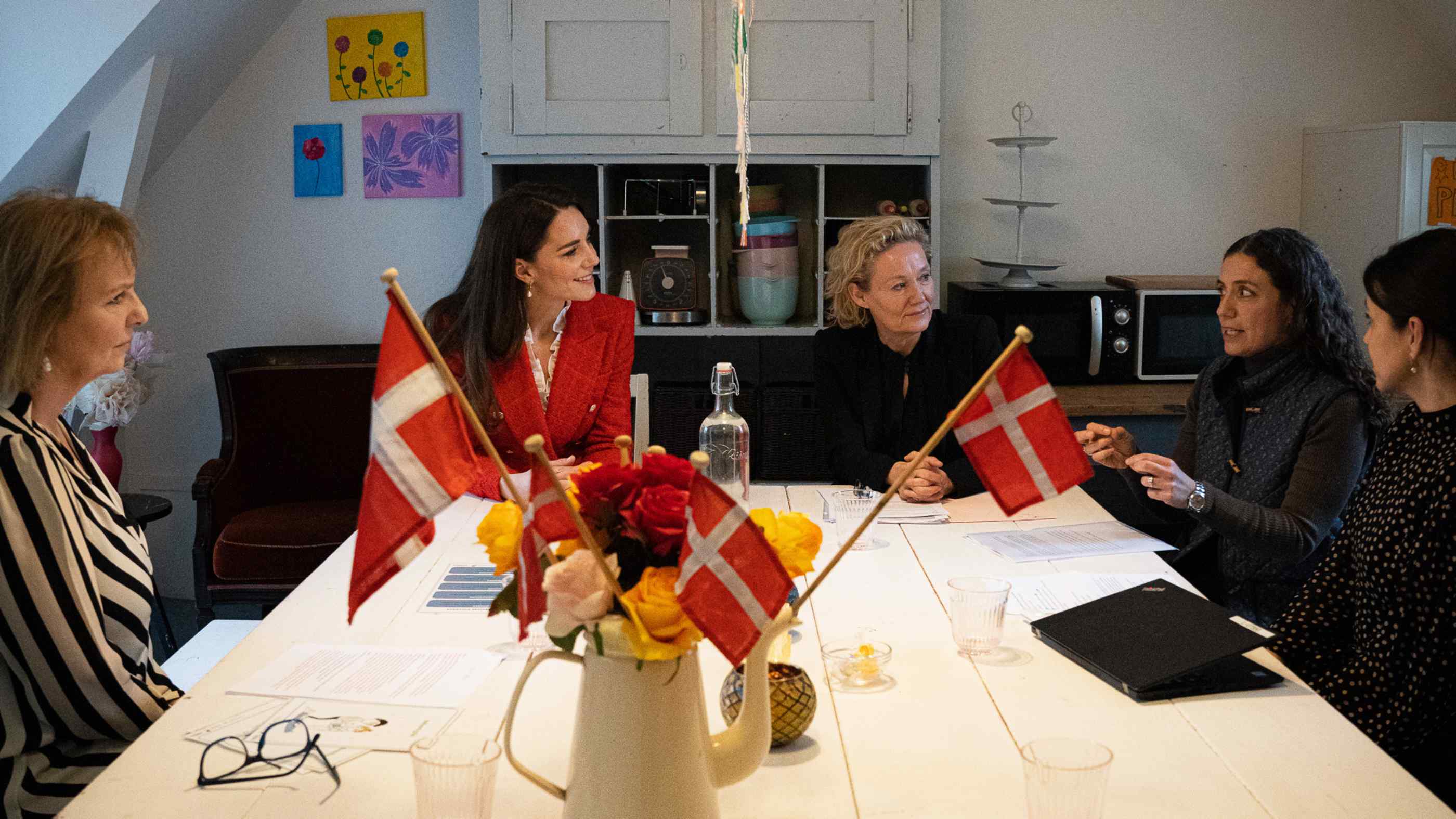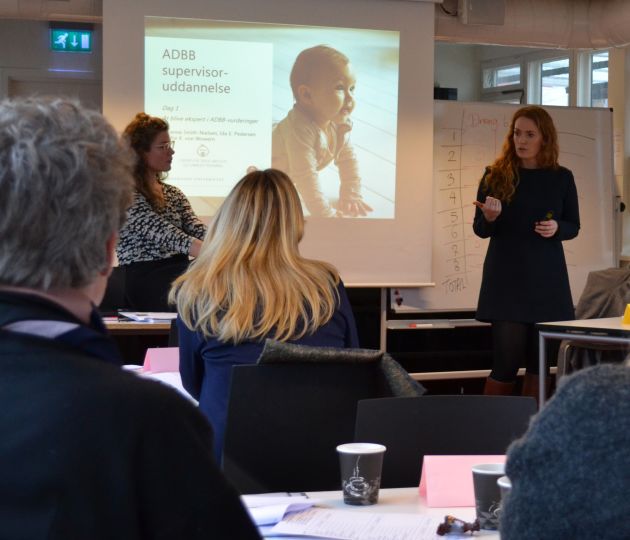Putting the socioemotional development of the infant on the agenda in primary care – Implementation of the ADBB in Denmark


The Princess of Wales during a visit to Denmark in February 2022.
At least 16% of children in Denmark will experience a mental health problem or illness before the age of 10. This not only has negative implications for their long-term mental health but can also affect their educational attainment, family functioning and establishment of friendships, and increases their risk of social marginalisation.
The consequences of early adversity and childhood mental health problems are far-reaching, resulting in lost opportunities and substantial human and economic costs, for the individual as well as society.
Extensive evidence indicates that our mental and physical health in adulthood, as well as the kind of parents we become, are influenced by our social and emotional experiences during early childhood. Therefore, it is crucial to prioritise early childhood mental health, including through the implementation of effective preventive interventions as well as early identification when issues arise.
The Copenhagen Infant Mental Health Project
In Denmark, the use of evidence-based mental health services has not advanced at the same rate as equivalent services for physical health. In 2015, to address this societal need, the Centre for Early Intervention and Family Studies at the University of Copenhagen, initiated the Copenhagen Infant Mental Health Project (CIMHP, Væver et al, 20151 ). This is one of a number of early childhood mental health research projects underway, towards our vision of establishing national standards for evidence-based, high-quality assessment and interventions to support mental health during early childhood across Denmark.
CIMHP (2015-2021) was established as a collaboration between the Centre for Early Intervention and Family Studies, the City of Copenhagen’s health visitors and the Copenhagen council department for children and youth. One of the central aims of CIMHP was to translate early childhood research into practice by putting the social and emotional development of the infant on the agenda in home visits in primary care. For this, we developed a training program for health visitors to be certified in the use of the Alarm Distress Baby Scale (ADBB, Guedeney & Fermian, 20022 ) and to use the ADBB as part of their routine support for families during home visits.
The ADBB equips health visitors to observe infant behaviours and to talk to parents about their baby’s social and emotional development using a nuanced language. During the course of the project, 250 health visitors from Copenhagen were certified in the ADBB. As other municipalities learned about it, they wanted to implement the ADBB too. To date the Centre for Early Intervention and Family Studies has trained and certified all health visitors in 82 out of the 98 Danish municipalities.

The ADBB equips health visitors to observe infant behaviours and to talk to parents about their baby’s social and emotional development using a nuanced language.
The wider context for health visiting in Denmark
Health visitors and the home visiting program are an important port of entry to the promotion of early childhood mental health in Denmark. The Danish national guidelines for infant and child healthcare are issued by the Danish Health Authority. Infant and child healthcare is delivered by health visitors in primary care at the municipality level. Health visitors are nurses with 1.5 years of additional training who deliver health promotion and prevention at the community level.
During the child’s first year, health visitors provide their services almost exclusively through home visits. The Danish Health Authority recommends there should be five or six home visits during the first year of the child’s life, but each municipality is free to decide the number (anywhere from two to eight). The service in the home visiting program is voluntary for the families, but it is widely used and highly accepted by parents. 98-99 % of all Danish families receive regular home visits by a health visitor in the infant’s first year of life (Danielsdottir & Ingudottir, 20203 ).
At each visit, the health visitor measures the growth of the baby and advises parents about their infant’s physical and nutritional needs etc. In recent years, there has been an increasing focus on infant social and emotional development, as evidenced by 82 municipalities having implemented the ADBB.
The ADBB in practice
The ADBB was initially developed for paediatric examinations and is a tool for the systematic observation and identification of persistent social withdrawal in infants aged 2-24 months, as an indicator of emotional distress.
Early social withdrawal is associated with longitudinal emotional and behavioral problems, as well as impaired cognitive and language development. The ADBB consists of eight items focusing on different aspects of infant social behavior, such as eye contact, facial expression, vocalisations, and activity level. Each item is rated on a scale from 0-4, with higher scores indicating less optimal social behavior. A total score of five or more is used as cutoff for social withdrawal. Ratings are based on observation of the infant’s behavior during a brief interaction (5-15 min) between the health visitor and the infant.
In all the municipalities that have implemented the ADBB, the ADBB assessments are registered into the digital journal system used by the health visitors in their daily practice. This means that, for the first time, we now have an almost national standardised measure of infant mental health risk in the first year of the infant’s life. In Denmark we are challenged by a data-gap and a lack of comprehensive knowledge about the number of young children (0-5 years) at risk, the duration and predictability of early childhood mental health problems, and the underlying developmental pathways. The ADBB is a first step in enhancing monitoring and establishing national, standardised, evidence-based data collection methods.
By utilising these data, we can gain a deeper understanding of the risk and resilience factors associated with early childhood mental health. However, in the implementation of the ADBB, each municipality has been responsible for establishing procedures and action plans for responding to the children and families identified as needing more support. While ADBB data is systematically registered, there is currently a lack of systematic evaluation of the interventions that follow its use.
Feasibility and validity of the ADBB within Copenhagen health visiting
As part of the CIMHP, we have examined the implementation and validity of the ADBB screening tool in the context of Copenhagen’s health visiting services. Our first study involved 79 health visitors who received training in the ADBB (Smith-Nielsen et al., 20184 ) . Most (92%) of the health visitors reported that the ADBB was feasible to use in their daily practice and that the ADBB made a positive contribution to their work. Further, the findings indicated that one year after implementation, approximately 80% of children had undergone at least one ADBB screening during their first year of life. This is a promising screening prevalence rate compared to other universal screening instruments (Rice et al., 20145 ). However, it is important to address the barriers that exist for screening the remaining 20% of children.
Furthermore, an item-response theory analysis was conducted on data from over 24,000 infants screened with the ADBB during their first year of life, demonstrating the tool’s good construct validity (Egmose et al., 20216 ). However, results from the CIMHP, along with a Norwegian study utilizing the ADBB (Heimann et al., 20107 ), show that a lower number of children are identified as socially withdrawn using the ADBB in Scandinavian contexts compared to other European studies (Guedeney et al., 20138 ). Thus, there is a need to establish a cut-off on the ADBB in a Danish context, which we will be doing in the near future.
Next steps for supporting early childhood mental health
The ADBB represents a major first step in establishing national standards for evidence-based, high-quality assessment of early childhood mental health across municipalities in Denmark. However, there is an ongoing process for securing the quality of ADBB implementation and the promotion of early childhood mental health.
To support this, as a next step, we have developed the universal psychoeducational program ‘Understanding Your Baby’. This was developed in response to health visitors expressing a need for more training to develop a wider vocabulary, and a systematic tool to support them in describing the infant’s socioemotional cues and behavior during ADBB observations – for all families not just those at-risk. Amongst other materials, Understanding Your Baby includes an online video library for parents and professionals (with English subtitles https://forstaadinbaby.dk/understand-your-baby).
References
[1] - Væver et al. BMC Psychology (2016) 4:57 DOI 10.1186/s40359-016-0166-8
[2] - Guedeney, A., & Fermanian, J. ( 2001). A validity and reliability study of assessment and screening for sustained withdrawal reaction in infancy: The Alarm Distress Baby Scale. Infant Mental Health Journal, 22, 559– 575.
[3] - Danielsdottir, S. & Ingudottir, J. (2020). The First 1000 Days in the Nordic Countries: A Situation Analysis. Copenhagen: Nordic Council of Ministers. https://pub.norden.org/nord2020-051/nord2020-051.pdf
[4] -Smith-Nielsen, J., Lønfeldt, N., Guedeney, A. & Væver, M.(2017) Implementation of the Alarm Distress Baby Scale as a universal screening instruments in primary care. International Journey of Nursing Studies, 79, s. 104-113. https://doi.org/10.1016/j.ijnurstu.2017.11.005
[5] - Rice, C. E., Naarden Braun, K. V., Kogan, M. D., Smith, C., Kavanagh, L., Strickland, B., ... & Centers for Disease Control and Prevention (CDC). (2014). Screening for developmental delays among young children—National Survey of Children’s Health, United States, 2007. MMWR Suppl, 63(2), 27-35.
[6] - Egmose, I., et al., How to screen for social withdrawal in primary care: An evaluation of the alarmdistress baby scale using item response theory. International Journal of Nursing Studies Advances,2021. 3. https://doi.org/10.1016/j.ijnsa.2021.100038
[7] - Heimann, M., et al., Sustained withdrawal at 3-, 6-, and 9-months: A first analysis of a Norwegianvalidation study of the Alarm Distress Baby Scale, in World Association for Infant Mental Health 12thWorld Congress June 30-July 3 Leipzig, Germany. 2010, Infant Mental Health Journal: Leipzig, Germany.p. 107.
[8] - Guedeney, A., Matthey, S., Puura, K., 2013. Social withdrawal behavior in infancy: a history of the concept and a review of published studies using the alarm distress baby scale. Infant Mental Health J. 34 (6), 516–531. https://doi.org/10.1002/imhj.21412.
